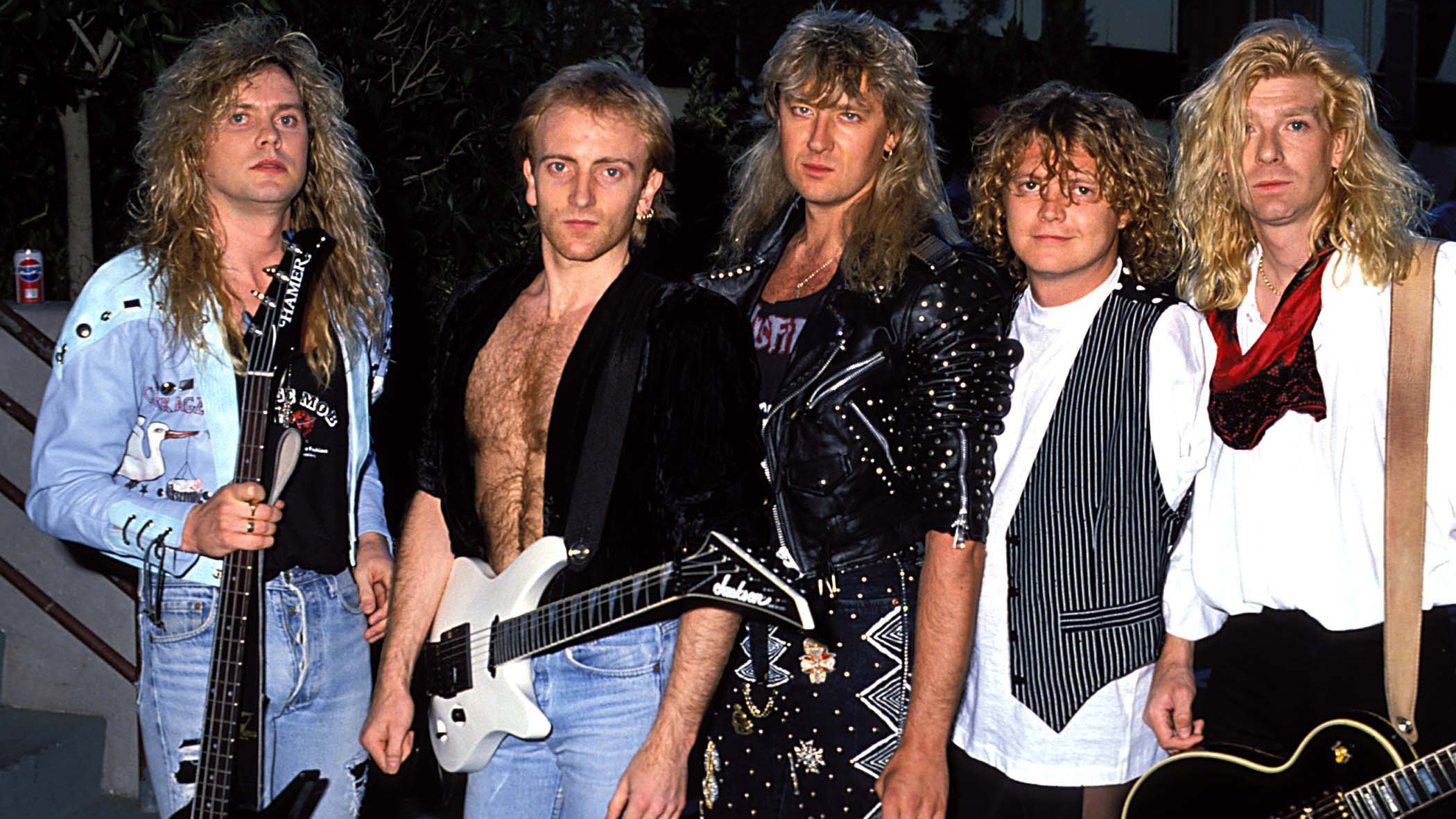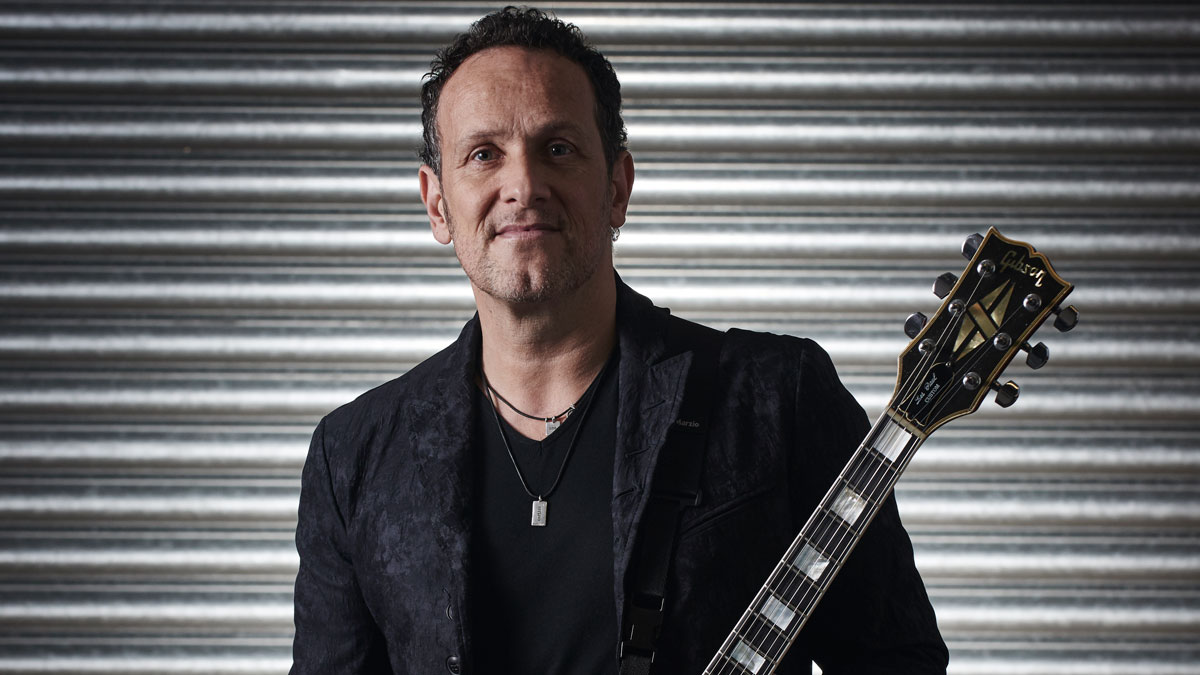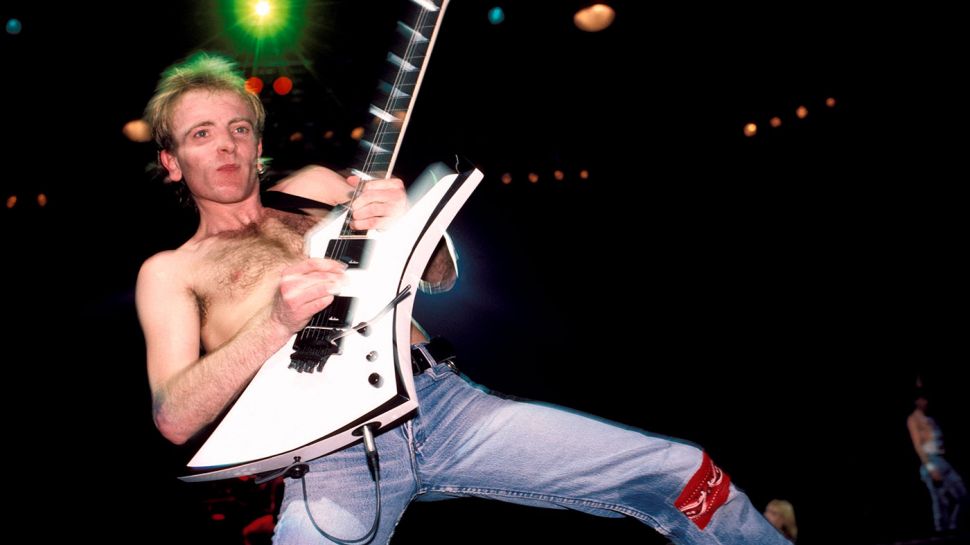6 songs guitarists need to hear by… Def Leppard
Highlights of a glittering, and sometimes tragic, career

From the pubs of Sheffield to the stadia of the world, the famous five have produced some of the most commercially successful music of any English rock band. In a career that has seen them experience both scintillating highs and crushing lows, it’s not been an easy ride and despite any lingering preconceptions rock fans may have, some of their songs are absolutely essential lessons in their craft. Here are just six to get you started.
1. Animal – Hysteria (1987)
Hysteria’s difficult birth has been well documented and, so drawn out and costly was its recording process, it was said that it needed to sell five million copies just to break even; thanks to songwriting of unparalleled quality it’s shifted over four times that amount and is still going strong.
The platinum-tinged production courtesy of mentor Robert John ‘Mutt’ Lange (Hysteria was their third album helmed by him) allows you to hear each and every tiny little guitar lick and phrase that makes up the lush layers of melody and rhythm that underpin proceedings, and we can recommend getting hold of the best pair of headphones you can and simply submerging into the music.
Animal demonstrates how to use guitars in highly inventively musical ways, from the clean modulation-drenched stabs that act as a counterpoint to the muted, single note riffs that hold the whole thing together, to the huge chorus corralled by radio-friendly rock tones.
"Animal alone took three years to do"
Phil Collen
Guitarist Phil Collen used a Gallien-Krueger 250ML for the introductory lick and that runs to feedback, while 99% of the remainder of the guitar tones came from a Tom Scholz Rockman, a forerunner of modern amp modellers.
Collen and cohort Steve Clark used a combination of Jackson, Fender, Gibson and Squire guitars to add yet more tonal colours to their arsenal and it still sounds incredible.
“Animal alone took three years to do; we kept changing it and redoing it. Guitarist Phil Collen told Guitar World. “Parts would be rewritten, tempos would shift, whole arrangements would come and go. At one point we redid the entire song under Joe’s vocal; Mutt just scratched everything and we started over.”
Want all the hottest music and gear news, reviews, deals, features and more, direct to your inbox? Sign up here.
Album sales initially stalled around the three million mark, but the release of the seminal Pour Some Sugar On Me a full year after the album first hit the streets reignited its momentum and, to date, Hysteria has sold over 20 million copies worldwide.
2. Hello America – On Through The Night (1980)
“I went on stage in a pair of bright-red trousers and a white shirt covered in hearts"
Joe Elliot
After grabbing a record deal with Phonogram and signing up to the hugely influential Leber-Krebs management stable, Leppard were assured of big things. Their debut was released in March 1980 and, as a consequence, they found themselves roped in with the NWOBHM even though their music couldn’t ever be classified as traditional metal, especially in comparison with the likes of compatriots Iron Maiden and Saxon, let alone the countless also-rans.
Inadvertently, Hello America crystallised suspicions that the band was more interested in finding success on the other side of the Atlantic than consolidating things at home, and the ill-feeling ultimately led to their appearance at that year’s Reading festival descending into an exercise in avoiding objects that were being hurled stagewards from the rabidly hostile crowd. Guitarist Pete Willis famously received a clod of turf in the conkers for his trouble.
“Some of it was self-inflicted,” sniffed vocalist Joe Elliott. “I went on stage in a pair of bright-red trousers and a white shirt covered in hearts. That was me going: ‘I’m not wearing a leather jacket and jeans like every other band in this movement that we don’t think we’re in anyway’.”
There’s little doubt that it riffs as hard as anything else back then and it’s a shame that the melodies and intelligently intertwining guitar lines that would became a Leppard trademark couldn’t counteract the negative reaction to the song’s lyrical content. Still, Steve Clark’s solo is a pertinent lesson in his ‘less is more’ approach, full of Ace Frehley-like trills and controlled fingering, and the super-precise rhythm guitar from Willis keeps things anchored.
The multilayered vocal intro and swirling synth bubbling under the chorus are certainly a step away from most rock songs of the time but the truth is that there wasn’t a single British band gamely rocking out in front of 18 people at the Coach & Horses who didn’t also dream of cracking the US. Ridiculously, accusations of selling out still rumble on today.
“We really weren’t that intelligent,” laughed bassist Rick Savage. “It was the lyrics of a kid fantasising. I can see how people read into it but it was way more innocent than that, way more naïve.”
3. High ‘N' Dry (Saturday Night) – High ‘N' Dry (1981)
With a bigger budget and a burgeoning relationship with Lange already bearing fruit, this was Leppard’s time. A strict working ethic had been drummed into them by their new producer and as a consequence the band knocked the album out in just three months, its commercial appeal invigorated by MTV’s heavy rotation of the tear-stained Bringin’ On The Heartbreak.
The title track is a far more upbeat affair and the robust lyrics, never likely to give the cerebral likes of Bruce Springsteen or Neil Peart sleepless nights, playfully describe the modest teenage requirements for a weekend bender.
Knowing now how overdoing the ‘whisky and wine’ affected both Willis and, more tragically, Steve Clark later on does take some of the shine off but both guitarists are lean and hungry here. Clark’s clever intro riff and Willis’ Angus-flavoured solo are just two of the highlights and the album as a whole paved the way for the successes that were to come.
“Because [High ‘N' Dry] wasn’t as successful as we would have liked, Mutt was hell-bent on making sure everything else we did was a hit.” remembered Savage. And that’s why we started taking so long to make records: it became personal.”
4. Rock Of Ages – Pyromania (1983)
With Pyromania the band really found their feet and, dispensing with four to the floor rock in favour of something richer and more considered, they struck pay dirt.
The first single, the rousing Photograph, effortlessly demonstrates this more melodic approach, while ROA mixes juddering rock guitars with a synth bass line to great effect, with Lange’s subtle production tricks increasing the impact: one involves sending individual guitar stabs far left and far right of the stereo picture in quick succession. Clever stuff.
Towards the end of the album’s recording process, and after ‘… hundreds…’ of warnings, Willis was fired due to one too many drunken screw ups and old compadre Phil Collen was quickly roped in to lay solos and embellishments over the existing Clark/Willis rhythm beds.
Lange gave him full reign to ‘go be the rock star’ and he duly obliged. The solo here is one of his best of the time, neatly mixing control and flash before climaxing with a bouncing a harmonic courtesy of the retrofitted Kahler vibrato of his Ibanez DT-555 Destroyer.
“It was great and I had a different feel and style to both those guys, it was a little more aggressive.” Says Phil. “My voice is more aggressive than what they had been used to too, and Mutt got me singing with Joe and doing all these two part harmonies. It started to change the sound of the band."
The bizarre faux-German ‘gunter, glieben, glauchen, globen’ intro, despite internet red herrings to the contrary, don’t mean anything literal and began life merely as a studio in-joke to combat the banality of yet another ‘one, two, three, four’ count-in as Lange demanded take after take. What’s more, in the song’s commercial video the phrase is mouthed by manager Peter Mensch.
5. Armageddon It – Hysteria (1987)
Such is Hysteria’s embarrassment of musical riches that we could have quite legitimately filled all six slots here from its tracklist. However we’ve chosen this beauty for two reasons; the chorus’s monstrous hook and Steve Clark’s inspired guitar solo.
Proving yet again that rock guitars don’t have to rage along at full throttle to provide power, there are parts of the verse here that actually feature no discernible six-string whatsoever. The main riff alternates with stabs while the verses are linked with licks played with such exacting precision it’s almost mesmeric, and when that lauded hook kicks in it’s like a boot to the temple.
As ever, the solo is part of the song rather than simply a flurry of notes laid on top of the rhythm track and Clark’s impossibly cool marching workout, played on an HSS Strat owned by Collen, not only fits the music perfectly but is also the defining moment of his style.
“There are little things like, ‘C’mon Steve!’ that really capture people’s imaginations.” Rick Savage told us. “When we sat down to write this it was originally a chord sequence that I came up with. [It was] basic and simplistic in the verse and it developed into something more sleazy and swaggery, in the way that some of the great Rolling Stones songs came out.”
The lyrical assurances that ‘… the best is yet to come…’ proved tragically over-optimistic as Clark, unable to free himself from his various addictions, died on 8 January 1991. While the rock world lost a great talent and the rest of the band a true friend, Leppard’s realistic chances of ever attaining such commercial and musical heights again also went with him.
6. Slang – Slang (1996)

Former Dio man on riders, guitar rigs and Spinal Tap moments
After Clark’s death and the underwhelming performance of 1992’s Adrenalize, it’s to the band’s credit that they took drastic action. Out went Mutt Lange and in came Pete Woodroffe on production duties, and, with former Dio and Whitesnake guitarist Vivian Campbell in the ranks, a new musical direction was sought and realised.
Darker both lyrically and sonically, the huge guitars are thrust right in your face, with pick scrapes, wah honks and histrionics flying all over the place. The hooks are still there, as are the melodies, but, thanks to certain personal issues being experienced by some of the band members the smiles have been replaced by scowls and you can almost hear the grinding of teeth as the song develops.
"We've never done a record in such a basic way, just using these things called ADATs.” Elliot explained at the time. “They're like video machines; they take tapes and each of those is an eight-track recorder. So you link them up with digital leads and you've got a 32-track recording [studio] that’s smaller than a washing machine."
Slang is a beguiling album, especially in the light of what had gone before, and is certainly worth seeking out.
6 songs guitarists need to hear by… Iron Maiden
Simon Bradley is a guitar and especially rock guitar expert who worked for Guitarist magazine and has in the past contributed to world-leading music and guitar titles like MusicRadar (obviously), Guitarist, Guitar World and Louder. What he doesn't know about Brian May's playing and, especially, the Red Special, isn't worth knowing.
